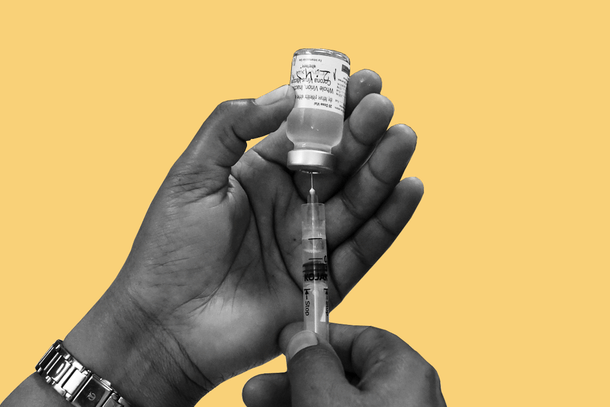Politics
Despite Kinks, New Vaccine Policy Is Doable And Eminently Sensible
R Jagannathan
Apr 21, 2021, 11:47 AM | Updated 12:29 PM IST
Save & read from anywhere!
Bookmark stories for easy access on any device or the Swarajya app.


Damned if you do, damned if you don’t. As expected, after shouting from the rooftops about the Centre’s flawed vaccine strategy, the opposition is now opposing the reformed vaccine policy, too.
First, it was said that the vaccines may be unsafe. It turned out they weren’t so, despite some adverse reactions. Next, after failing to curb the second wave of Covid, they shouted about vaccine shortages and that the vaccine allocation strategy was discriminatory against non-BJP (Bharatiya Janata Party) states.
States, they said, should be given the right to vaccinate anybody they please. Now that that has been done, they want one-nation-one-vaccine price. In short, states should be able to eat their federal rights cake and also have a free lunch at the Centre’s expense. (Read what other opposition parties have to say here and here).
One can only imagine what would be the case if the Centre agreed to that too; the opposition would then probably say that the entire vaccine strategy was intended to fatten the pharma and vaccine manufacturing industry at the cost of the taxpayer and the poor.
This is not to suggest that the new vaccine policy announced on 19 April is criticism-proof; it’s not. But it is more or less the right way forward at more or less the right stage in our fight against the pandemic, which is showing a massive surge right now.
Before discussing the warts and gaps in the new policy, let us first summarise its main elements. The new policy allows the Centre to buy half the vaccines produced at the same cost as now from manufacturers, and this supply will be used to vaccinate all people in the priority age groups of 45 and above for free at government hospitals and clinics.
Next, states will be allowed to procure directly from manufacturers at prices to be negotiated with the latter but announced in advance. Private hospitals and companies can also buy the vaccine at market rates, which too will need to be notified in advance, from 1 May.
Lastly, in order to ramp up supplies, the Centre has offered advances (against future supplies of vaccines) of Rs 4,500 crore (Rs 3,000 crore for Serum Institute of India, which makes Covishield, and Rs 1,500 crore to Bharat Biotech, which makes Covaxin). If all things go well, by the end of May or early June, vaccine demand will start being met fully even for the expanded universe of eligibility – which is all those above the age of 18.
The two flies in the ointment are this: how do we stop rich states from bidding up the price where the poor states get stranded without additional vaccines due to unaffordability?
Second, how will prices be determined in this topsy-turvy market where there is one monopoly buyer with huge regulatory powers (the Centre), other powerful buyers with their own regulatory powers; and private players who will have to pay high prices that will essentially be used to subsidise the first two buyers?
Will we then have three sets of prices for the same product? Or even more price bands, if each private player negotiates his own price with the manufacturer?
It is surely messy, but this is the price we pay for ensuring that the masses get their vaccines free of cost.
Hopefully, we will get some clarity when the detailed guidelines are issued by the Centre. But some possible ways out could include this:
One, the Centre could constitute a negotiating team comprising state representatives – or states could form this themselves – to negotiate good prices for the collective without forcing the vaccine makers to suffer losses and thus lose interest in ramping up production. The right price is the one where states find it affordable, and manufacturers make some profits on the deal.
Two, states can be allowed to levy a short-term cess on their own goods and services tax rates – say for six months – to recover the costs of subsidising vaccines for the 18-45 age groups. The rest, those above 45, are anyway covered by the Centre’s own free vaccine policy.
Three, the free market should be really free, and could include private hospitals, clinics, and companies that want vaccines for their own staff.
This implies a three-tier price structure – ranging from Rs 150 per dose to something twice or thrice that level for states, and upto Rs 1,000 for private institutional sales.
For an Infosys, vaccinating all its staff at Rs 2,000 per recipient (of two doses at Rs 1,000 each), will cost less than Rs 50 crore. Small and medium companies with staff of 20-30 or 100-500 may find it tougher, but even here one-time costs of Rs 40,000-60,000, or Rs 2 lakh to Rs 10 lakh respectively, cannot be said to be excessive given the potential losses that could happen due to prolonged closures of factories and workplaces due to the threat of Covid. It’s actually insurance, not an unproductive cost.
These costs could be lower, as some of the eligible recipients may anyway be covered by state and central schemes.
It may not be perfect, but it’s doable. And sensible.
Jagannathan is former Editorial Director, Swarajya. He tweets at @TheJaggi.





